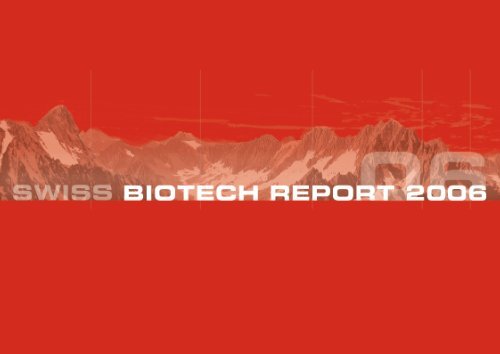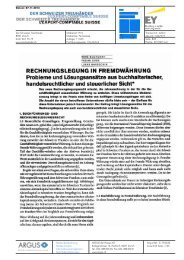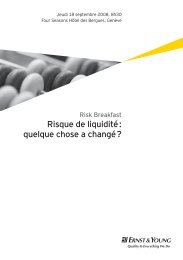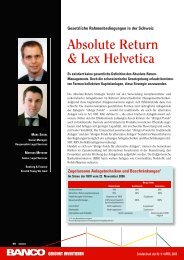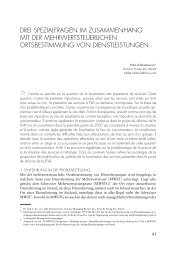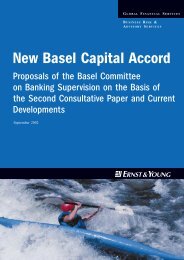Swiss Biotech Report 2006
Swiss Biotech Report 2006
Swiss Biotech Report 2006
Create successful ePaper yourself
Turn your PDF publications into a flip-book with our unique Google optimized e-Paper software.
02 WHY SWITZERLAND?USEFUL ADDRESSES ON BIOTECHNOLOGY IN SWITZERLANDCentral database of the <strong>Swiss</strong> biotech sector<strong>Swiss</strong> foreign investment agency<strong>Swiss</strong> export promotion agency<strong>Swiss</strong> innovation promotion agencyCentral database of the <strong>Swiss</strong> life sciences sectorThe <strong>Swiss</strong> Federal Institute of Intellectual PropertyInvestors and finance<strong>Swiss</strong> private equity and corporate finance associationInvestor databaseSWX <strong>Swiss</strong> Exchange, the <strong>Swiss</strong> stock exchangeNational competence networkswww.whoch6.chwww.swissbiotechassociation.chwww.swissbiotechnet.chRegulatory environmentwww.swissmedic.ch/md.aspwww.bag.admin.chwww.swissreg.chTrade associations and supportwww.economiesuisse.chwww.interpharma.chwww.ey.com/chwww.swissbiotech.orgwww.locationswitzerland.chwww.osec.chwww.kti-cti.chwww.swisslifesciences.comwww.ige.chwww.seca.chwww.swisslifesciences.comwww.swx.com
SWITZERLAND IS ...03… a successful biotech locationDear ReaderSwitzerland is a prime location for biotech companies.The <strong>2006</strong> edition of the <strong>Swiss</strong> <strong>Biotech</strong> <strong>Report</strong> providesa good overview of the opportunities availableand serves as an information gateway to the <strong>Swiss</strong>biotech community.Having identified biotechnology as a key factor in futuredevelopment, the <strong>Swiss</strong> government has undertakenvarious efforts to create an attractive businessenvironment for this sector. <strong>Biotech</strong>nology enjoys afavourable regulatory and administrative environmentin Switzerland: Product registration cycles are shortand innovative drugs, biotech products and servicesenjoy easy access to the markets. On the administrativeside, the Federal Coordination Centre for <strong>Biotech</strong>nology(www.contactbiotech.ch) acts as a onestopprocessing centre for notification of activitiesand applications for authorisation.What makes this country such a successful biotechlocation? In a technology-friendly environment, Switzerlandboasts a qualified and highly motivated workforce.Stable political and social conditions, a flexiblejob market as well as an effective infrastructure andattractive tax framework – all of these make Switzerlanda rewarding choice for any innovative company.The country also offers an efficient technology transferbetween higher education institutions and industry,thus enabling innovation, high quality and sustainablegrowth.The proximity to the country’s prestigious pharmaceuticaland chemical industries and internationalknowledge clusters make Switzerland an ideal placeto set up your biotech business.The unique combination of advantages describedhere together with innovative and vibrant researchand business communities make Switzerland a truebiotech gem in the heart of Europe.Joseph Deiss, Minister of Economic Affairs
04BIOTECH COUNTRYSWITZERLANDBIO VALLEYGREATER ZURICH AREABASELZURICHLAUSANNEGENEVABIO ALPSBELLINZONABIO POLOSwitzerland lies at the heart of one of the world’s leading biotechnology regions,which also includes the neighbouring areas of France, Germany and Italy.The <strong>Swiss</strong> biotech industry is among the largest and most diversified in Europe.
INDEX 05USEFUL ADDRESSES ON BIOTECHNOLOGY IN SWITZERLAND . . . . . . . . . . . . . . . . . . . . . . . . . . . . . . . . . . . . . . . . . . . . . . . . . . . . . . . . . . . 02PREFACE / by Joseph Deiss, Minister of Economic Affairs . . . . . . . . . . . . . . . . . . . . . . . . . . . . . . . . . . . . . . . . . . . . . . . . . . . . . . . . . . . . . . . . . . . . . . . . . . . . . . . 03A PRIME BUSINESS LOCATION FOR LIFE SCIENCE COMPANIES / by Location Switzerland . . . . . . . . . . . . . . . . . . . . . . . . . . . . . . . . . . . 06INDUSTRY STATEMENTS Interviews with Ernesto Bertarelli (CEO Serono), Alice Huxley (CEO Speedel), Urs Tuor (CEO GlycoVaxyn) . . . . . . . . . . . . 08WHAT KEEPS SWISS BIOTECHNOLOGY GOING? / by Oreste Ghisalba, CTI, the <strong>Swiss</strong> Innovation Promotion Agency . . . . . . . . . . . . . . .10AN EXPONENTIAL INCREASE IN STRENGTH / Company portrait: Santhera, Liestal . . . . . . . . . . . . . . . . . . . . . . . . . . . . . . . . . . . . . . . . . . . . . . . .12JOINING FORCES AND CONCENTRATING STRENGTHS / by Daniel Gygax, <strong>Swiss</strong> <strong>Biotech</strong>net . . . . . . . . . . . . . . . . . . . . . . . . . . . . . . . . . . . . 13PARTIAL REVISION OF SWISS PATENT LAW / by Heinz Müller, <strong>Swiss</strong> Federal Institute of Intellectual Property . . . . . . . . . . . . . . . . . . . . . . . . . .16BIOTECH PROJECTS ATTRACT THE LION’S SHARE OF VENTURE CAPITAL / by Maurice Pedergnana, SECA . . . . . . . . . . . . . . . . 18LICENSED FOR SUCCESS / Company portrait: Helsinn, Lugano . . . . . . . . . . . . . . . . . . . . . . . . . . . . . . . . . . . . . . . . . . . . . . . . . . . . . . . . . . . . . . . . . . . . . 20ONE NATION ONE BIOTECH CLUSTER / by Domenico Alexakis, <strong>Swiss</strong> <strong>Biotech</strong> Association . . . . . . . . . . . . . . . . . . . . . . . . . . . . . . . . . . . . . . . . . . 21CONDITIONS FOR RAISING CAPITAL HAVE GOTTEN BETTER / SWX round-table discussion with financial experts . . . . . . . . . . . . . . . 23SWISS BIOTECH INDUSTRY ON THE MOVE IN 2005 / by Jürg Zürcher and Markus Blaser, Ernst & Young . . . . . . . . . . . . . . . . . . . . . . . . . 26COMPETITION FOR ANTIBODIES / Company portrait: Molecular Partners, Zurich . . . . . . . . . . . . . . . . . . . . . . . . . . . . . . . . . . . . . . . . . . . . . . . . . . . . . 28POWERFUL PARTNERSHIPS / Benefits for big pharma and for biotech companies . . . . . . . . . . . . . . . . . . . . . . . . . . . . . . . . . . . . . . . . . . . . . . . . . . . . . 29PROGRAMMED DEATH FOR TUMOUR CELLS / Company portrait: Apoxis, Lausanne . . . . . . . . . . . . . . . . . . . . . . . . . . . . . . . . . . . . . . . . . . . . . . . 30MILESTONES IN MODERN BIOTECHNOLOGY / Timeline . . . . . . . . . . . . . . . . . . . . . . . . . . . . . . . . . . . . . . . . . . . . . . . . . . . . . . . . . . . . . . . . . . . . . . 31APPENDIX / <strong>Swiss</strong> <strong>Biotech</strong> Survey by Ernst & Young and the <strong>Swiss</strong> Federal Institute of Intellectual Property . . . . . . . . . . . . . . . . . . . . . . . . . . . . . . . . . . . . . 32
06 A PRIME BUSINESS LOCATION... >>• A highly skilled and quality-conscious workforce,experienced in precision operations – a worldleader in terms of productivity. For the US biotechcompany Isolagen, which specialises in autologouscellular therapies, the highly qualified multilingualworkforce was a decisive factor in its choosing Bevaixin the Canton of Neuchâtel as a new location.LOCATION SWITZERLAND With 138 biotech companiesand 91 biotech suppliers, Switzerland boaststhe highest biotech density worldwide comparedwith the number of inhabitants. In 2005 the <strong>Swiss</strong>biotech industry generated a turnover of almostCHF 6 billion with a workforce of over 14’400.Located in the heart of Europe, the <strong>Swiss</strong> biotech industryis in close proximity to important biotech areasin neighbouring Germany, France and Italy and istherefore a perfect gateway to the EU markets thatinclude well over 450 million consumers.Why is Switzerland the best location for yourbiotech business?• A sophisticated scientific environment with leading-edgecompetence in life sciences, nano- andmicrotechnology and biotech equipmentThe innovative products of <strong>Swiss</strong> biotech companiesregularly win international prizes.Three <strong>Swiss</strong> companies have recently been honouredwith the European <strong>Biotech</strong>nica Awards: In2004, Prionics won first prize, with Cytos coming inthird, and Speedel finished second the following year(2005).Out of a total of 523 European biotech products indevelopment pipelines (of listed companies only), 109come from Switzerland. This second-place rankingin European terms illustrates the country’s innovativecapabilities.The basis for this ongoing success is the intensifiedcollaboration and exchange of knowledge within anetwork of institutes, universities and private companies.“SystemsX”, the national initiative in systemsbiology founded by the <strong>Swiss</strong> Federal Institute ofTechnology in Zurich, is just one example. In cooperationwith the Universities of Basel and Zurich, thisprogramme reformulates research problems in orderto speed up the generation of clinically applicableresults which can then be used by the industry. “SystemsX”has announced a further collaboration withRoche in the area of diabetes. This innovative industry/academicpartnership translates systems biologyresearch into improved medicines in order to findnew pathways for diabetes drugs.According to Isolagen’s chairman Frank DeLape,“The acquisition of the campus is the result of a comprehensivesearch for a facility capable of providingus with the logistical flexibility and scalability to expandour international operations. This site was selectedfor several reasons including the highly educated,multilingual workforce, its location in theZurich-Geneva life science and biotech corridor andexcellent transportation infrastructure, making iteasy to reach all locations within the European-MiddleEastern-Asian region.”• A stimulating environment for young, innovativestart-ups with science parks and incubatorsInnovative ideas and new products can be easilylaunched in Switzerland. Take the Eclosion sciencepark near Geneva, for example: This revolutionaryproject boasts a new structure that allows accelerateddevelopment for new companies in high-tech sectors.Government and private sector efforts combinein a dynamic and innovative framework: The stateprovides funding for the operations of the incubatorand private investors provide the capital necessary tocreate the new firms. The park is located in the Centerfor New Technologies in Plan-les-Ouates, whereSerono Pharmaceutical Research offers space at veryfavourable conditions. Each of Switzerland’s businessregions has its own science parks.
... FOR LIFE SCIENCE COMPANIES07• Access to the European market and to more than450 million consumers of products and servicesfrom SwitzerlandGood contractual relations with the European Unionand the country’s central geographical location provide<strong>Swiss</strong>-based companies with an excellent platformfrom which to access the European market.For these reasons, Millenium Biologix AG selected itsZurich site as the starting point for its European expansion.The company’s investment in Switzerlandincludes R&D laboratories, production facilities,a marketing unit and a regional office for regulatoryaffairs. The importance of its <strong>Swiss</strong> site will growwith the planned launch of new clinical products.• Attractive fiscal system and encouraging administrativeand regulatory frameworkA very favourable tax environment with moderateoverall taxation is a key advantage of a businesslocation in Switzerland. The maximum corporate taxrate was 21% in 2005, which is one of the lowest inEurope. The biotech industry benefits from an encouragingadministrative and regulatory frameworkfor companies, as well as low payroll taxes.Additional advantages are short product registrationcycles and easy access to markets.• Leading financial centre in Europe and beyondThe SWX is a leading European stock exchange asfar as the market capitalisation of listed life sciencecompanies is concerned. In addition, the sector-specificindex family that includes SXI LIFE SCIENCES ®and SXI BIO+MEDTECH ® increases both visibility andliquidity for domestic and foreign biotech companies.• Wide choice of venture capital and private equityfundsSwitzerland, with over 40 venture capital firms andprivate equity funds, various science parks and incubators,is a very inviting environment for innovativestart-up companies. For example, the Basel-basedcompany Speedel was able to raise a total of CHF 227million in private risk capital through several roundsof financing. The value of the company increased fromround to round, and in September 2005 it was admittedto listing on the <strong>Swiss</strong> Exchange (SWX), reachingan initial capitalisation of CHF 950 million.The total venture capital flown into <strong>Swiss</strong> biotechcompanies amounted to CHF 295 million in 2005,which gives Switzerland an excellent third-placeranking in Europe.• www.swissbiotech.org: your entry portal to the<strong>Swiss</strong> network in biotechnologyA database of over 800 <strong>Swiss</strong> life science and biotechcompanies provides free and direct access to the<strong>Swiss</strong> biotech knowledge network. R&D cooperationbetween institutions of higher education and theprivate sector are further promoted by Switzerland’sfour regional biotech clusters BioValley, Greater ZurichArea, BioAlps and Biopolo Ticino.LOCATION SWITZERLAND......the <strong>Swiss</strong> foreign investment agency, informspotential investors on Switzerland as a businesslocation and works together with the cantonalbusiness promotion representatives in selectedmarkets and industry clusters to actively pursuemarketing for Switzerland as a business location.@For further information please visitwww.locationswitzerland.chwww.swissbiotech.org
08 INDUSTRY STATEMENTSERNESTOBERTARELLI,CEO SERONO“Our goal is to complementour existing businessesand in-house projects andcontribute to our long-termgrowth.”Based in Geneva, Serono is a global biotech leaderwith eight biotechnology products. In addition tobeing the world leader in reproductive health,Serono has strong market positions in neurology,growth and metabolism and has recentlyentered the psoriasis area.What are the advantages for a global biotech companysuch as Serono to have its headquarters inSwitzerland?Ernesto Bertarelli: As a centre of first-class scientificresearch, especially in life sciences, Switzerland hasproven to be an excellent location for a global biotechcompany. There are many examples of fruitfulcooperations with <strong>Swiss</strong> universities or federal institutesof technology as well as with start-up companies.For example, in 2005 we established a partnershipwith the Universities of Geneva and Lausanne tocreate a joint professorship for research in reproductiveendocrinology and we signed an agreement withthe Geneva-based product development companyNovImmune that grants us exclusive rights to developand commercialise two fully human monoclonalantibodies. Switzerland’s favourable environment hasbeen supportive to our growth since we moved ourheadquarters here in 1977. I am convinced that thespectacular growth of our company is a result of political,social, environmental and cultural factors thatcome together here.How is Serono reacting to the consolidationprocess that is taking place in the European biotechindustry?Ernesto Bertarelli: In the biotech industry, size is notthe determining factor of success. Creativity, innovationand dynamism are the keys to discovering newdrugs. At Serono, we continue to make good progressin R&D. Supplementing our in-house R&D effortis a very active programme in business development.Our focus includes new indications within therapeuticareas where we already have a presence, as well astargeting new therapeutic areas with high unmetmedical needs such as autoimmune disease and oncology.Our goal is to complement our existing businessesand in-house projects and contribute to ourlong-term growth.The biotech sector, which is highly dynamic andcompetitive, puts a premium on flexibility and continuousinnovation. How do you ensure that Seronomaintains a competitive edge?Ernesto Bertarelli: At Serono, we cultivate a verycompetitive and challenging internal culture while atthe same time emphasising teamwork. We are guidedby a strong vision and the capability to reinvent ourselvesto adapt to changing competitive factors. Wework in an entrepreneurial spirit in multiple centres ofexcellence around the world in which people interactand cooperate with one another very effectively.ALICE HUXLEY,CEO SPEEDEL“Switzerland is an excellentlocation for any entrepreneurlooking to build a successfulbiotech business.”The biopharmaceutical company based in Basel,develops therapies for cardiovascular and metabolicdiseases. The company is a world leader inthe field of renin inhibition, an innovative approachin the treatment of cardiovascular problems.How do you rate the <strong>Swiss</strong> biotech industry in aEuropean context?Alice Huxley: The numbers speak for themselves –the world’s highest density of biotech companies perpopulation, second in Europe in terms of revenue andmarket capitalisation of the sector, about CHF 1.4 billioninvested in R&D per year. These excellent figuresreflect the key factors which enable the <strong>Swiss</strong> biotechindustry to flourish: leading-edge scientific expertise,a highly skilled and quality-conscious workforce,an established world-class pharmaceuticalindustry that acts as both a springboard and as acustomer for new companies, a networked infrastructurefor innovation to thrive, extensive financingsources with knowledge and commitment in the sector.In short, Switzerland is an excellent location for
any entrepreneur looking to build a successful biotechbusiness!How does Speedel respond to the consolidationprocess taking place in the European biotechindustry?Alice Huxley: Industry consolidation is a naturalprocess of evolution: It can be the result of two weakcompanies joining forces to hopefully benefit fromshared resources, it can occur when a small youngcompany becomes so successful that it attracts theattention of a larger established firm with deeperpockets, it may reflect the fashion of that year for aparticular technology or disease expertise that becomesthe “must-have item” irrespective of cost.Speedel’s current strategy is to remain independentand to become profitable, using our core strengthsof focused innovation and smart drug developmentfor treating cardiovascular and metabolic diseases.However, we recognise that Speedel is not immuneto the forces of consolidation – and we are readyto respond either offensively or defensively as appropriate.The biotech sector is highly dynamic. Flexibility andinnovation are among the major factors in stayingcompetitive. How does Speedel guard against takingit easy?Alice Huxley: We live daily by our motto: “at the heartof value creation”. Whatever we do, it has to be judgedagainst that benchmark of creating value for patients,partners and investors. Our entrepreneurial culture ischaracterised by being resultdriven, ethical, peopleoriented, focused and trustworthy. Speedel’s futuresuccess will depend on our ability to maintain thesequalities even as the organisation grows in scale andcomplexity.URS TUOR,CEOGLYCOVAXYN“The investment horizon ofinvestors has been drasticallyshortened, and having productcandidates in phase II has almostbecome a precondition forventure capital investments.”The company was incorporated in November 2004as a spin-off of the ETH Zurich. Today the biotechnologycompany operates in its own facilities nearZurich. GlycoVaxyn is dedicated to the developmentof novel biotechnological methods for the productionof glycoconjugates in bacterial cells. It offers asolution for producing therapeutic glycoproteinsfaster and at lower cost.How do you, as the CEO of a young start-up company,evaluate Switzerland as a biotech businesslocation?Urs Tuor: Very positively as regards the low-cost accessto infrastructure and accessible networks withexperts from the biotechnology field.Numerous other biotech start-ups are open to exchanginginformation and sharing their experiences.Although there are sufficient venture capital investorsand financial resources for follow-up and expansionfinancing, institutional and public funding for earlyphasetechnology development is only available on alimited basis. Business angels who could fill this need09are still too rare due to the lack of expertise andcapital.What are the crucial factors that allow a youngcompany to raise capital or enter into partnershipswith large companies?Urs Tuor: The investment horizon of investors hasbeen drastically shortened, and having product candidatesin phase II has almost become a preconditionfor venture capital investments. Venture capital investorshave pulled out of the seed and early-stagefield almost completely. Reliable proof-of-conceptdata are critical for survival in order to obtain start-upfinancing or to enter into R&D collaborations withlarger industrial partners. In addition, the compositionof the management team is always a decisive criterion,which means that young companies will probablyhave deficits in one of these areas, which they willhave to cope with.Flexibility and innovation are among the most importantfactors that allow a company to remaincompetitive. How do you prevent your companyfrom getting sluggish?Urs Tuor: As a very young and still small start-up, wedo not have this problem, at least not yet. Discussionswith industry representatives are for us the bestway to develop ideas for new applications and projectsand if possible to implement them ourselves orwithin the framework of cooperative arrangements.@For further information please visitwww.serono.comwww.speedel.chwww.glycovaxyn.ch
10WHAT KEEPS SWISS... >>THE INNOVATION PROMOTION AGENCY CTI Whatrole does the CTI, the national innovation promotionagency, play in connection with Switzerland’s effortsto promote research and technology?Oreste GhisalbaAlongside the <strong>Swiss</strong> National Science Foundation(SNF), the CTI is Switzerland’s most important nationalorganisation for the promotion of research. Whereasthe SNF focuses mainly on fundamental research,the CTI has a dual focus on promoting applied researchand development projects (aR&D) through public-privatepartnerships and on establishing and developingstart-ups. In addition, CTI also has the goal of assuringthe efficient and result-oriented transfer of knowledgeand technology.Through its Life Sciences section, the CTI providesthe biotech sector in Switzerland with the followingforms of support:• Backing for regular CTI aR&D projects based on apublic-private partnership model (50/50 funding asa basic rule)• Facilitating a straightforward and seamless transitionfrom SNF to CTI funding, for example forfollow-up projects to innovative R&D approachesstemming from the National Centers of Competencein Research (NCCR)• Discovery Projects (new CTI initiative) promotingR&D approaches for which it is not yet possible tofind a completely committed business partner.These projects have an extremely high innovationand market potential yet still involve a high risk offailure.• Help in setting up new companies through CTIStart-upIn addition, the strategic CTI <strong>Biotech</strong> initiative makesa significant contribution towards optimising the generalR&D structural conditions for biotechnology inSwitzerland – based on the principle of “help for selfhelp”,wherever possible. Its main goals are to eliminaterecognised structural deficiencies, to efficientlyutilise dormant synergy potentials, and to create newsynergies and networks. This is matched by efforts tostimulate interest in new research areas and applicationfields. A stepped-up dialogue among stakeholdersleads to significant new impulses for the successfulfuture development of the <strong>Swiss</strong> biotech sector asa whole.CTI Start-up provides valuable professional assistanceto entrepreneurs who are forming start-ups and spinoffs:scientific and business coaching on how to optimisebusiness areas and business plans, and supportin project management, partnering and networking.Companies that successfully complete this optimisationprocess are awarded the CTI Start-up label, whichimproves their chances of securing financing. Overone-third of the more than 100 CTI Start-up labelcompanies to date are from the life sciences sector.Another service that CTI launched in 2004 was venturelab,an entrepreneurial training programme.INTERNATIONAL APPROACHCTI is actively involved in creating an internationalimage for <strong>Swiss</strong> biotech players from the businessand academic communities (under the marketing label<strong>Swiss</strong> <strong>Biotech</strong>). This is important because the <strong>Swiss</strong>biotech scene needs to effectively sustain opportunitieson the international stage, to and to open up new
... BIOTECHNOLOGY GOING?11markets. In addition to the United States, the regionof Central and East Asia (Japan, China, Korea, Singapore,India, etc.) is a key market for biotech productsand services from Switzerland and also for new jointventures and R&D partnerships.The agency’s so far most important international successwas achieved in Japan. In the autumn of 2005,a memorandum of understanding was signed betweenthe Japan Bioindustry Association (JBA) and the<strong>Swiss</strong> <strong>Biotech</strong> Association (SBA) on the occasion ofSwitzerland’s participation in Bio Japan 2005. Thetask now facing the CTI is to actively implement theagreement with JBA. For this purpose, the agency hasalso entered into an agreement with the Japan ExternalTrade Organization (JETRO) in Geneva to promotecloser cooperation between the two countries.CORE BIOTECH COMPANIESAND BIOTECH SUPPLIERSOne strength of the <strong>Swiss</strong> biotech industry is that thenumber of core biotech companies and biotech suppliers,and their activities, are well balanced. Bothtypes of companies and their effective interaction areimportant to the success of the biotech industry as awhole. There is still considerable potential for optimisationas regards strategic R&D collaborations betweensmall and medium-sized enterprises specialisingin biotech.The CTI makes a contribution in this area, too, by increasinglylending its support to small and largescalecollaborative projects that involve several businesspartners and/or several academic partners. Acurrent example of this type of a more complex a R&Dapproach is the CTI-funded TERRAFORS project.Participants in this project include the environmentalbiotech firm Madep, the instrument and equipmentmanufacturer Infors and the Institute of Microbiologyat the University of Neuchâtel. The common goal wasto develop, validate and launch a new solid-phasespherical bioreactor for use in a variety of applicationfields, including environmental biotechnology. Thebusiness areas of the two companies complementone another, resulting in a nice win-win situation. Thebioreactor concept stems from research done at theUniversity of Neuchâtel and by the spin-off companyMadep. When it came time to implement the conceptwithin the framework of the partnership, Infors wasresponsible for designing the equipment and instrumentation.Infors has a commercial interest in marketingthe TERRAFORS bioreactor for a wide rangeof R&D applications. Madep uses the reactor tooptimise actual biological environmental clean-up processes(such as customised bioremediation of contaminatedsoil). The TERRAFORS solid-phase bioreactorwas launched in 2005 and has now also wonthe <strong>Swiss</strong> Technology Award for <strong>2006</strong>.Prof. Dr Oreste Ghisalbais Head of CTI <strong>Biotech</strong>.CTI THE INNOVATION PROMOTIONAGENCY...…promotes projects in applied research and development(aR&D) that are carried out jointly by private-sectorbusinesses and academia. The organisationprovides funding solely for the academicparticipants in the form of salaries for around 1,000researchers each year. In addition, CTI Start-upsupports the establishment of high-potential growthcompanies with an international focus. By buildinga bridge between the lab and the market, CTI furthersthe innovation process that drives the economy.Businesses benefit doubly from this mission:both from project results and from the supply ofqualified, market-oriented R&D professionals. Forthe period 2004 through 2007, CTI’s fundingamounts to approximately CHF 400 million.@For further information please visitwww.kti-cti.chwww.ktistartup.chwww.venturelab.ch
12AN EXPONENTIAL INCREASE IN STRENGTHSANTHERA The company which was formed in 2004as the result of the merger between Graffinity Pharmaceuticalsand MyoContract is living proof that amerger between two smaller companies that complementone another in terms of products and personnelcan uncover previously hidden reserves ofstrength.In mid-2003, both the management and the investorsof Graffinity Pharmaceuticals AG, a German companybased in Heidelberg, agreed that – in order to competesuccessfully in the market in the future – thecompany would have to change its business model.At that time, Graffinity Pharmaceuticals had a technologyready to be launched on the market, as wellas a preclinical programme for type 2 diabetes, butexpanding these two projects into a profitable businesswithin a short time frame was not feasible. “Wetherefore took the view that an M&A transaction wasthe best route to provide us with the late-stage productswhich we needed,” explains Santhera’s CEOKlaus Schollmeier, who was at that time CEO of Graffinity.At the same time as Graffinity was reassessing its future,the management of MyoContract AG in Baselwas also involved in intensive discussions about howthe company should progress. In order to get its firstproduct into phase III clinical development, it wasclear that MyoContract needed both additional investmentas well a more rounded and experiencedmanagement team. Management decided to pursue adouble strategy: either to complete another round ofventure capital financing or to take the opportunity ofa merger with a complementary biotechnology firmas a way to create a more robust platform for its futuregrowth.OUTSTANDING COMBINATIONFrom left:PD Dr Thomas Meier, CSOBarbara A. Heller, CFODr Helmut Kessmann, CBODr Klaus Schollmeier, CEOGraffinity and MyoContract eventually made contactwith one another, partly due to to the Graffinity team’sexperience in M&A. “It quickly became clear thatthere was an excellent fit between the two businessesand that together we could create a company with areally exciting future,” says Schollmeier. Nothingstood in the way of a merger, and so in July 2004 thetwo companies came together to establish SantheraPharmaceuticals AG, which is headquartered in Liestal,Switzerland. “Being located near to Basel, thestrongest major pharmaceutical and biotech clusterin Europe, provides us with a major competitive advantage,”says Schollmeier who assumes the positionof CEO at Santhera.Today Santhera is one of Europe’s leading late-stageprivate companies and is focused on the identification,development and marketing of new therapies forneuromuscular diseases. The pipeline currently includesone product in clinical phase III for the treatmentof Friedreich’s Ataxia, one product in phase IIfor the treatment of Duchenne Muscular Dystrophy,and three late-stage preclinical development projectsfor the treatment of Duchenne Muscular Dystrophy,Cancer Cachexia as well as type 2 diabetes. In orderto maintain a tight business focus, Santhera lookedfor a partner for its type 2 diabetes programme basedon its expertise with DPP-IV inhibitors. In mid-2005Santhera succeeded in signing a potentially very lucrativelicensing deal for the development and commercialisationof these novel compounds with theSwedish company Biovitrum, which specialises inthis therapeutic area. The final step in creating thenew Santhera took place in late 2005 when it spun offits screening technology service division,@which wasstill based in Germany, through a management buyout.For further information please visitwww.santhera.com
JOINING FORCES... >>13NETWORKS In order to make the <strong>Swiss</strong> biotech industrymore innovative and responsive to the market,a number of universities, companies, trade associationsand the CTI, the national innovation andpromotion agency, have joined forces in recentyears to develop various projects and competencenetworks.Thanks to the pharmaceutical industry’s long-standinghistory in Switzerland, the country has an outstandingnetwork of suppliers as well as innovativebasic research institutes at the universities. The universitiesof applied sciences, which have really succeededin establishing themselves over the last fewyears, have likewise developed a very good reputationin the area of life sciences. In order to utilisethese strengths even more effectively, various initiativeshave recently been formed with the aim of improvingnetworking between the various players inthe <strong>Swiss</strong> biotech sector.NATIONAL COMPETENCE NETWORKSBy establishing national competence networks like<strong>Swiss</strong> <strong>Biotech</strong>net (see article on pages 14–15) and<strong>Swiss</strong> Foodnet, the national innovation and promotionagency CTI has played a very active role in shapingapplied life science research and development atboth the traditional universities and the universities ofapplied sciences. This has made it possible to implementmany high-quality projects and attract a mountingnumber of interested business partners. Anothermilestone was the formation in 1998 of a powerful andeffective professional association for the bioindustry– another project in which the CTI was also activelyinvolved. Thanks to its goal-oriented and efficientmanagement and a growing membership, today’s<strong>Swiss</strong> <strong>Biotech</strong> Association is becoming ever more dynamicand important in stature, while also establishinga political lobby for the biotech sector.Since 2004, the <strong>Swiss</strong> <strong>Biotech</strong> Association and <strong>Swiss</strong><strong>Biotech</strong>net have also been involved in a joint CTIproject entitled “Industry solution for simplified knowledgemanagement in biotechnology”.The CTI set up a knowledge and technology transfer(KTT) system in 2005. This structural tool is designedto provide the biotech sector with important newideas and fresh impetus. In future, technology transfershould function according to a push-pull model sothat the business community (primarily small andmedium-sized enterprises) can be more actively integratedinto the process than before.A good example of this is the “w 6 consortium” whosemembers include not only the <strong>Swiss</strong> <strong>Biotech</strong> Association,which has taken on the role of industry pool forthe life sciences, but also partners from industry andscience. The aim of w 6 is to strengthen technologytransfer between universities and business in order tofurther improve existing activities and integrate themmore effectively into a network.The consortium has therefore set itself the followingstrategic goals:• To support existing projects and innovative modelsthat stimulate the pull process; to dismantle barriers,particularly between small and medium-sizedcompanies (the business community in general) andthe universities; and to promote the push process.
14 ... AND CONCENTRATING ... >>• To guarantee high-quality services in support ofthe KTT projects on behalf of all the participatingacademic partners in the push-and-pull area.• To identify and utilise synergies and opportunitiesfor cooperation between universities of appliedsciences and the traditional universities.• To expand competence and contact networks for allthe partners involved.Another successful networking example is the “SystemsX”national project, an initiative to support andpromote systems biology. This project combines theworld-renowned expertise of the <strong>Swiss</strong> Federal Instituteof Technology in Zurich (ETH Zurich), and its focuson the areas of technology and science, with theexcellent biological, medical and nanotechnology researchcentres of the University of Basel and the acclaimedlife sciences department of the University ofZurich. By combining and integrating the competenciesof a number of <strong>Swiss</strong> universities and institutes,the foundation has been laid for an interdisciplinaryapproach to systems biology.Unlike modern biology, systems biology studies thecomplex processes of an entire biological systemrather than mere molecular details. Support is requiredfrom many different disciplines, in order to gain anunderstanding of the system as a whole. Informationtechnology is needed, for example, in order to handlethe enormous amount of data. Other influential disciplinesare physics, engineering sciences, mathematics,chemistry and bioinformatics. And now industryhas been added to this concentrated transfer ofknow-how. Roche, for example, has announced a collaborationagreement with “SystemsX” in the areaof diabetes.@For further information please visitwww.whoch6.chwww.kti-cti.chwww.swissbiotechassociation.chMORE VALUE THROUGHGREATER IMPLEMENTATIONSWISS BIOTECHNET Greater enterprise value canbe delivered through innovation. And innovationcomes about when ideas are implemented. <strong>Swiss</strong><strong>Biotech</strong>net is a strong partner in this process.Daniel GygaxEvery analysis confirms it. A company with a high degreeof innovation in its portfolio will generate higherbusiness value over the long term. For example, theshare price of DSM rose by 46 per cent in 2005, at arate far outstripping growth in that sector. The abilityto produce innovative products smoothly and efficientlyis therefore crucial for business. <strong>Swiss</strong> <strong>Biotech</strong>netcan make an important contribution to theseprocesses by bringing together the expertise of the<strong>Swiss</strong> universities of applied sciences into one network,which is easily accessible to industry. The totalvolume of projects implemented in the area of bioanalyticsproduction of biomolecules and tissue engineeringhas grown to over CHF 20 million in the lastfive years.ATTRACTIVE SERVICE PROVIDERIn tandem with the implementation of innovative researchprojects, the network is making a name for itselfas the provider of custom-tailored training andcontinuing education programmes.One specific, intensive course was developed for Hoffmann-LaRoche AG, for example, at which laboratoryand chemical technicians receive further training in
...STRENGTHS15biotechnological processes – from mammalian cellsto pharmaceutical products. The network took on thejob of <strong>Swiss</strong> coordinator in order to utilise the specificcore competencies of the universities ofapplied sciences.HIGH QUALITY OF APPLIEDRESEARCH PROJECTS<strong>Swiss</strong> <strong>Biotech</strong>net supports companies in research atall stages of development and production, from theindividual cell to bioreactors and purified biomolecules.One example is the improvement of liquid culturesin disposable plastic containers for Wave technology,a project carried out by the Professors Regineand Dieter Eibl at the University of Applied Sciences(UAS) in Wädenswil. Manufacturers of therapeutic antibodies(such as Avastin) who are dependent on theproduction of high-quality cell cultures can benefitfrom this technology. Professor Christiane Zaboroschof the Zurich University of Applied Sciences in Winterthurand scientists from the UAS in Sion assistscompanies in carrying out the subsequent purificationprocesses. In this case, the network contributesexpertise relating to the purification of monoclonalantibodies from cell supernatants, including analysisof the binding strengths of the purified antibodies, anexpertise which is available at the UAS of NorthwestSwitzerland in Muttenz.IMPLEMENTATIONCENTRALISED AND EASYSupporting business-critical applications is alwaysof key importance in <strong>Swiss</strong> <strong>Biotech</strong>net research projects.Professors Angelika Viviani of the University ofApplied Sciences in Wädenswil and Ursula Grafof the Zurich University of Applied Sciences in Winterthurworked together with Berna <strong>Biotech</strong> AG ona project to produce an innovative vaccine againsthepatitis B. This is produced in cell cultures to whichno cattle-derived growth additives are added, as hadpreviously been the norm. The new vaccines are thereforefree of potential protein impurities. This logicalchange in the culture medium means, however, thatalternative methods of cell growth improvement mustbe found and that the subsequent purification operationsmust also be modified. Here too, the networkacted as a catalyst by providing the newest findingsfrom various research laboratories so that the lattercould be utilised for these applications of great economicsignificance. It goes without saying that qualitycontrols are always part of the process. Companiescan therefore activate the innovative power of <strong>Swiss</strong><strong>Biotech</strong>net on several levels: for collaborative researchprojects as well as for comprehensive andcustom-tailored continuing education courses.Professor Daniel Gygaxis President of <strong>Swiss</strong><strong>Biotech</strong>net and Head ofBioanalytics at theUniversity of AppliedSciences of NorthwestSwitzerland.SWISSBIOTECHNET...…helps industry partners in gaining access toexpertise at <strong>Swiss</strong> universities of applied sciencesand in applying that know-how to their own productionoperations. In addition to innovativeresearch projects, <strong>Swiss</strong> <strong>Biotech</strong>net is becomingincreasingly well known as a provider of customdesignedcontinuing education programmes forcompanies.@For further information please visitwww.swissbiotechnet.ch
16 PARTIAL REVISION OF SWISS PATENT LAW...BIOTECH PATENTS The economic and scientificsignificance of biotechnology has increased enormouslyand will continue to grow. Now that itspatent law is being revised, Switzerland will increasinglybenefit from the growing importance ofthis field.Heinz MüllerThe patenting of biological material or even of livingorganisms is not a new phenomenon. Although thenumber of patent applications has increased sharplyin the last few decades with the expansion of molecularbiology, a living organism was patented way backin 1873. This US patent was issued to Louis Pasteurand covers not only the method for preparing a sterileyeast culture for beer manufacture but also the yeastitself. The first patent applications for plants followedat the end of the 19th century, and the first patent applicationsfor genetically modified organisms werefiled in the early 1980s.PATENT PROTECTIONHIGHLY IMPORTANTSince that time, biotechnological inventions have beenthe subject of numerous international, European andnational patents, some of which have been filed by<strong>Swiss</strong> companies. Because the economic importanceof the biotech industry has grown enormously in theinterim, the significance of patenting biotech inventionshas also increased enormously and often representsone of the most important assets of a start-upcompany.Current <strong>Swiss</strong> patent law, however, does not sufficientlytake into account the fact that inventions inthe area of biotechnology involve biological material.Biological material is reproducible, often highly complex,and sometimes cannot be adequately describedso that specimens must be filed with a patent applicationin order to guarantee disclosure and reproducibility.For this reason, certain sections of the currentlaw must be revised and amended.The goal of these changes is to provide effective andappropriate protection for biotechnological inventions.A patent law revision focusing on the patenting ofbiotechnological inventions has therefore been set inmotion. The plan was to harmonise patent law withEU <strong>Biotech</strong>nology Directive No. 98/44/EC, which theEuropean Patent Office (EPO) has also made part ofits guidelines.The changes listed below are intended to guaranteepatent protection for biological material and methods– protection that is justifiable on social and ethicalgrounds and is also appropriate for the pharmaceuticaland biotech industries and for academic research.EFFECTIVE PROTECTIONA patent is a legal right granted by a governmentfor a limited period of time to prevent others frommaking, using or selling an invention. Patents areboth an incentive and a source of revenue for researchand development, in particular for thoseareas involving high-cost, high-risk inventions suchas for biotech inventions. Furthermore, patentprotection gives companies the competitive edgenecessary to survive in today’s fast-developingand continually changing marketplace.THREE NEWLYFORMULATED SECTIONSThree newly formulated sections covering the area ofbiotechnology will be explained below on the basisof the draft revision of patent law as adopted by theFederal Council in its legislative message of 23 November2005.a) Are genes patentable?According to Directive 98/44/EC, isolated genes assuch are patentable. In Switzerland, however, naturallyoccurring genes would be excluded from patentingunder the new law. This is a restriction of patentabilitythat goes substantially beyond the practice appliedby the EPO. However, it would continue to be possibleto patent “derived sequences” such as the cDNA producedby PCR, under the condition that at least onefunction of these sequences is known. This meansthat the properties and applications of sequences thatare derived from gene sequences must already bedescribed in the patent application. Adding them lateris no longer possible. This is intended to preventspeculative patent applications.b) Are human beings and their body parts patentable?Respect for human dignity shall be guaranteed inthat the human body as such, in any given phase ofits formation and development, is excluded frompatentability. This also corresponds to Directive98/44/EC. In addition, human physical components intheir natural environment shall also be excluded frompatenting, again in agreement with the EU directive.They are also excluded because they are only discoveriesand not patentable inventions.
...POSITIVE FOR BUSINESS AND RESEARCH17This applies to all living things in general: The subjectof a patent is not the living organism in its natural environmentbut a technical teaching as to how humanbeings can utilise nature in a new way for commercialpurposes. The technical beneficial effect makes thediscovery an invention under patent law. On the otherhand, isolated and perhaps technologically modifiedcomponents of the human body outside their naturalenvironment (such as isolated and possibly geneticallymodified blood cells) are patentable.c) Which ethical values are considered in patenting?Except for inventions whose exploitation wouldviolate public order or morality, patent law takes intoaccount generally binding moral and ethical valueswhen issuing patents. However, only violations of fundamentaland therefore permanent values justifydenial of a patent since there are often as many as 10years or more between the time the patent applicationis filed and the date the invention is first exploitedor used. Value systems and standards can changeduring that time. It would therefore be unfortunate orregrettable if a patent were denied for an inventionwhose exploitation becomes unproblematic duringthe potential protection period of 20 years due to achange in social or political values and standards.These fundamental values are not only mentioned inthe general clause quoted above but are also illustratedby explicit exclusion criteria in the new patentlaw. Examples are the cloning of human organisms,chimeras with human germ cells, modification ofhuman germ line cells or unmodified human embryonicstem cells. These exclusion criteria also correspondto Directive 98/44/EC.Professor Heinz Müller isan expert in patents andtechnology at the <strong>Swiss</strong>Federal Institute of IntellectualProperty and alecturer in Medical Biochemistryat the Universityof Basel.THE SWISS FEDERAL INSTITUTEOF INTELLECTUAL PROPERTY...…is the federal competence centre for all mattersdealing with patents, trademarks, designs andcopyrights. The broad range of services offered bythe institute can be divided into three areas: propertyrights, information products and training. Theissuance and administration of property rights isthe institute’s core business. Information productssuch as research into technological developments(novelty searches) and trademark searches are importantmarket-oriented services for our clients. Inaddition to these services, we offer training coursesin all areas of intellectual property rights.@For further information please visitwww.ige.ch
18BIOTECH PROJECTS ATTRACT... >>SECA Because of its outstanding stories of valuecreation, the <strong>Swiss</strong> biotech sector attracts a significantamount of venture capital. A lot of this fundingcomes from members of the <strong>Swiss</strong> Private Equityand Corporate Finance Association (SECA), whoseaim is to support biotech companies in their questfor growth from early stage and IPO to M&A activities.Maurice PedergnanaThe members of SECA take a positive view of the<strong>Swiss</strong> “ecosystem” – the word used to describe thefavourable regulatory and legal framework for runninga business in Switzerland. In this country, a largenumber of university and medical research facilities,and pharmaceutical companies can be found asR&D partners and as a source of experienced management,as well as spin-offs. Alongside the pharmaceuticalfirms clustered in the Basel area, largerbiotechnology companies also provide a market forearly-stage drug licensing cooperation agreements,an increasingly important factor in the financing ofbiotechnology ventures.HIGH DEMAND FOR JOB GROWTHThe <strong>Swiss</strong> biotechnology sector has delivered severaloutstanding value creation stories – namely Actelion,Basilea and Glycart <strong>Biotech</strong>nology – with many morestill to be told by promising firms making their way tothe market. As a result, the sector attracts a significantamount of venture capital today.Statistically, biotechnology and life science projectsattract the lion’s share of venture capital in Switzerland.One sign of the popularity of this particular sectoris the high demand for industry professionals andjob growth. Switzerland provides an outstandinglyattractive business climate for biotechnology companies.Amgen, the world’s biggest biotech firm, choseto locate its headquarters for its international commercialoperations outside of the United States, Canadaand Japan in Switzerland (with 300 employees)– but not its newest production plant: It feared it wouldnot be able to immediately find the more than 1,100employees required for its aggressive ramp-up plans.With a consolidation trend well underway amongbiotechnology companies in Europe and Switzerland,SECA members have a role to play. This includes corporatefinance companies with experience in mergersand acquisitions in the life science sector as well asindividual members offering due diligence, analysisand other pre- and post-transaction services.POOL OF EXPERTSThe majority of investors in early-stage ventures inthe <strong>Swiss</strong> biotechnology sector are SECA members,including HBM Partners AG VI Partners, Global LifeScience Ventures AG, Vinci Capital, Index VentureManagement SA, BioMedinvest AG, and NextechVenture, as well as international companies such as 3iGroup plc and Apax Partners.Pan-European venture funds, such as Sofinnova,HealthCap, NeoMed and Life Science Partners, whilenot members, are also networked into the organisation.These players invest not only in Switzerland, butalso abroad, and subsequently bring this expertise toyoung biotech companies in the region.The SWX <strong>Swiss</strong> Exchange is the favoured market for<strong>Swiss</strong> biotech companies going public. The exchangeis home to both <strong>Swiss</strong>-based companies and internationallife science companies that have a primaryor secondary listing here. In 2005, two out of theeleven companies to complete an IPO or achieve alisting were venture-backed biotech companies,namely Arpida and Speedel.A SWX listing is supported by a large number ofstock market analysts and fund managers who understandthe capital requirements of biotech firmsand the markets in which they operate, as well as theavailability of legal advisors and investor relationscompanies.
...THE LION’S SHARE OF VENTURE CAPITAL 19SOURCES OF FINANCE FOR BIOTECHSThe <strong>Swiss</strong> financial community has responded as the biotech sector has grown. The past three years have seen the creation of anumber of funds focusing on private equity and venture capital financing. Although the financial community is prudent with investmentsin economically difficult times, the financing sector remains strong. With more than 40 venture capital firms and sector-specificinvestment funds, Switzerland offers an excellent climate for biotechnology and other life science companies.The Two Most Important Associations in <strong>Biotech</strong>• SECA <strong>Swiss</strong> Private Equity&Corporate Finance Associationwww.seca.ch• CTI Investors Associationwww.cti-ia.chA Selection of Venture Capital Funds• Adamant Biomedical Investment Ltdwww.adamantinvest.com• Aravis Partners AGwww.aravis.ch• Aventic AGwww.aventic.com• BB <strong>Biotech</strong> AGwww.bbbiotech.com• BioMedinvestwww.biomedinvest.ch• ErfindungsVerwertungs AG, Baselwww.eva-basel.ch• Gebert Rüf Foundationwww.grstiftung.ch• Genevestwww.genevest.ch• Global Life Sciences Ventureswww.glsv-vc.com• HBM Bioventureswww.hbmbioventures.com• Index Ventureswww.indexventures.com• Nextech Venture Ltd.www.nextechventure.com• New Venture Technologieswww.newventuretec.com• Novartis Venture Fundwww.venturefund.novartis.com• Partners Group, Zugwww.partnersgroup.ch• Varuma AGwww.varuma.ch• VenturePartners AGwww.venturepartners.ch• Vinci Capitalwww.vincicapital.ch• VI Partnerswww.ventureincubator.ch• W. A. De Vigier Foundationwww.devigier.ch• Zürcher Kantonalbank Start-up Financewww.zkb.chA Selection of Equity Funds for Life Sciences• Clariden Healthcare Equity Fundwww.clariden.ch• CS Equity Fund Global Pharmawww.creditsuisse.com• Lombard Odier Inv. Life Scienceswww.lombardodierdarierhentsch.com• Sarasin – HealthSarwww.sarasin.ch• <strong>Swiss</strong>canto (LU) Equity Fund Health Carewww.swissca.com• UniSector – BioPharmawww.union-investment.com/ch• Vontobel Global Trend Life&Healthwww.vontobel.chA Selection of Equity Funds for <strong>Biotech</strong>• Clariden <strong>Biotech</strong>nology Equity Fundwww.clariden.ch• CS Equity Fund (Lux) Global <strong>Biotech</strong>www.creditsuisse.com• Lombard Odier Immunology Fundwww.lombardodierdarierhentsch.com• Pictet Global Sector Fund (L) – <strong>Biotech</strong>www.pictet.com• <strong>Swiss</strong> Life Funds – Equity Biomedicalwww.swisslife.com• UBS Equity Fund – <strong>Biotech</strong>www.ubs.comSECA...…is the <strong>Swiss</strong> platform for professionals active inventure capital, private equity, and corporate financeactivities, as well as the legal, investor relations,and accountancy services that support suchactivities.SECA’s 200 members represent four interest groups:innovation and venture capital, private equity, corporatefinance and legal and tax. It offers membersmonthly panel discussions and sponsors annualevents for investors and entrepreneurs as well aspublishing a series of research-based books andstatistics.Maurice Pedergnanais Secretary General ofSECA.@For further information please visitwww.seca.ch
20LICENSED FOR SUCCESSHELSINN This family-owned company, based inLugano, focuses on the in- and out-licensing ofvaluable biotech and pharmaceutical compoundsup to the highest quality standards – a uniquebusiness approach that is the key to the Group’ssuccess.From left:Enrico Braglia, Joint Managing DirectorGabriele Braglia, President of the BoardRiccardo Braglia, Joint Managing DirectorHelsinn’s mission is quite intricate: The company inlicenses,finances, develops, manufactures, thenout-licenses and supports innovative, value-addedpharmaceutical products. “We are able to take earlystageproducts and foster them all the way throughto the point where they secure a market position,”explains Enrico Braglia, Joint Managing Director ofHelsinn along with his brother Riccardo.The company, founded in 1976 by Gabriele Braglia,the father of Riccardo and Enrico, is wholly ownedby the Braglia family. “In the beginning, Helsinnwas purely a licensing company, but in the 1980s itbranched out into clinical development and manufacturingactivities.”FDA APPROVED“We develop and manufacture high-quality ActivePharmaceutical Ingredients (APIs) and drug productson behalf of third parties, too.” For this reason, thecompany has built state-of-the-art facilities in Switzerlandand Ireland. “We have more than 100 m 3 of reactorcapacity in our plants in Switzerland and Ireland,and our <strong>Swiss</strong> facilities have been successfully inspectedby the FDA,” says Enrico Braglia. “Our plantsalso provide drug products in oral and topical dosageforms for our contract manufacturing partners andour licensees.”During the last five years, R&D investment has totalledover CHF 160 million. Helsinn achieves net revenuesof CHF 300 million, is present in more than 70 countriesand employs 450 people. Its specialists havebroad expertise in the areas of pain and inflammation(Nimesulide), oncology (Becatecarin), supportive care(Palonosetron) and gastroenterology (Klean-Prep).HIGH-QUALITY COMPOUNDSHelsinn’s business approach differs from that of otherpharmaceutical groups engaged in licensing. Thecompany acquires the rights to new compounds whenthese are at the clinical stage of development. “Wethen complete development up to European and USFDA standards and subsequently market the productsthrough our worldwide network of partners.” Its100 partners in 70 countries include large pharmaand local companies. “Our proven expertise and thefact that we always deliver valuable compounds,while also offering our partners a complete packageof services and support, has earned us a very goodreputation in the pharmaceutical industry.” AlongsideHelsinn’s long experience and proven track record,the high quality of the company’s compounds is alsoattributable to its being in private ownership. Whichmeans, as Braglia explains, “we are not under pressurefrom the stock markets and can thus devote ourattention to developing one product at a time, with nogreat urgent need to pinpoint possible new in-licensingcandidate compounds.”Although the family is of Italian origin, the Bragliabrothers are not considering moving the company’sregistered office. “The favourable tax conditions, ahighly skilled and quality-conscious workforce, adense network of universities and research institutesand the central geographical location guarantee usan attractive environment for our business”@For further information please visitwww.helsinn.com
ONE NATION ... >>21SWISS BIOTECH ASSOCIATION Thanks to a vigorousforward strategy, membership in this nationalindustry association continues to grow. More than130 companies are already benefiting from variousnational and international projects.Domenico AlexaxisOne of the most important strategic goals of the <strong>Swiss</strong><strong>Biotech</strong> Association (SBA) is to create added valuefor its members. For example, the association is currentlyworking on an Internet-based platform thatwill provide biotech companies with an easy and inexpensivemethod of procuring information. Preparationsare underway to expand the platform to includeinternational recruitment and resource-sharing application.The non-profit project is being supported bythe CTI (the national innovation promotion agency),the University of Applied Sciences in Wädenswil andthree SME companies, and the SBA.STRATEGIC CONCENTRATIONOF FORCESA project entitled “ProBio – <strong>Swiss</strong> <strong>Biotech</strong> Center”(SBC) aims to bundle the strengths of the national researchand development community and thus providefresh impulses for new biotech processes. Whatmakes this project outstanding is successful linkingof interests from the academic sector (EPFL, UNIL,CHUV, etc.) with those of the universities of appliedsciences and industry – primarily small and mediumsizedcompanies (SMEs). The initiative’s goal is tosupport its partners in their efforts to obtain suitablematerial for clinical trials by creating a suitable infrastructurefor the production of biomolecules in accordancewith GMPs (good manufacturing practices) –under realistic financial conditions and within realistictime frames. The initial development phase has alreadybeen completed. Depending on its economicsuccess, the project will be further expanded in thecoming years at the centre in Monthey (BioArk).EUROPE AND SWITZERLAND —RESEARCH NETWORKSThe SBA also offers support to its members acrossnational boundaries, since economic cooperation betweenSwitzerland and Europe opens up major opportunitiesfor companies and research organisationsalike.In order to understand the decision-making structurein Brussels and to make rapid progress in biotechresearch, more and more specialised knowledge isrequired. With research and innovation becomingmore global, the importance of international networkingand sharing of expertise will continue to increase.The <strong>Swiss</strong> biotech industry is well positioned in theglobal landscape, but constant effort and innovationare required in order to maintain this position. TheSBA therefore provides direct and non-bureaucraticaccess to up-to-date information and competent supportin the area of European research and innovationprogrammes.
22... ONE BIOTECH CLUSTER“WHITE BIOTECHNOLOGY”WORKING GROUPLeading chemical companies are exploring the opportunitiesthat have been opened up by modern biotechnology,especially in the field of “white” or industrialbiotechnology. And they are also applying thesetechnologies, wherever it makes sense. The SBA takessuch initiatives seriously and has formed a workinggroup specifically dedicated to white biotechnology.The <strong>Swiss</strong> Industrial Biocatalysis Consortium is animportant partner in this effort. The group includesleading multinational companies that support whitebiotechnology as a pillar of economic growth. Theplanned activities are in agreement with OECDstrategies.In partnership with the <strong>Swiss</strong> <strong>Biotech</strong>net (see pages14/15) the SBA develops training programmes and usefulsupport tools for the industry. It is of importancethat the industry specifies its training needs so thatthe academic side can create tailor-made education.This strategy ensures that the industry gets the rightworkforce with the right education. The SBA profitsfrom the marketing alliance “<strong>Swiss</strong> <strong>Biotech</strong>” (see box)in a multiplied form. Thanks to <strong>Swiss</strong> <strong>Biotech</strong>, thesector is internationally visible. The project-specificparticipating companies (most of them young and internationallyless savvy) find a comprehensive partnerwhich is helping to put them in the public window.The participating Life Science Regions are importantinternal carriers of the dynamics in the <strong>Biotech</strong> sector,thus enhancing the common understanding of theindustry. This and more knowledge is brought intoEuropa Bio, the European <strong>Biotech</strong> Association, wherethe SBA is an active member.Domenico Alexakisis Executive Directorof the <strong>Swiss</strong> <strong>Biotech</strong>Association.SWISS BIOTECH......is an alliance of four leading <strong>Biotech</strong> regions ofSwitzerland (Bio Alps, BioPolo Ticino, Basel Areaand Greater Zurich Area). They have combined effortsto streamline interests of the national biotechsector. The SWX <strong>Swiss</strong> Exchange holds a leadingposition in terms of lifescience listings and offerscompanies from that industry – be they located inSwitzerland or abroad – access to an internationallyrecognised financial marketplace. The initiativewas co-founded by the SBA which also managesthe executive office of <strong>Swiss</strong> <strong>Biotech</strong>.@For further information please visitwww.swissbiotechassociation.chwww.swissbiotech.org
CONDITIONS FOR RAISING CAPITAL ... 23ROUNDTABLE Yvonne Wegmann (SWX <strong>Swiss</strong> Exchange),Harry Welten (Arpida), Irene Püttner (BankSarasin), Thomas Bieri (Investment Banking DepartmentUBS) and Maurice Pedergnana (SECA) discussthe biotech sector’s potential.In 2003, there was hardly any money for biotechcompanies. Things were looking up somewhat in2004. How do you assess the year 2005?Yvonne Wegmann: After the IPO window swung openin 2004, there was a decrease in IPO activity in theUnited States in 2005, but conditions in Europe havecontinued to improve. A total of 13 biotech companieswent public in 2005 on regulated European markets.Harry Welten: In general, we can see that financingactivities in the biotech sector are on the upswing. Inspite of the inherent risks, investors show increasedinterest in this sector. We can only hope that thistrend will continue and that investors will remain interestedin biotech.6.4%8.5%4%16.2%3.4%7%Market Cap.> USD 260 bn21.4%33.4%HealthcareBanksFood and beveragesInsurancesIndustrial goods and servicesCyclical goods and servicesChemicalsOtherFigures based on SPI companies/source: SWX <strong>Swiss</strong> ExchangeSWX Industry Breakdown as per 31 Dec. 2005Irene Püttner: It was striking that the price of someEuropean IPOs in 2005 was at the lower end of theprice scale and several announced IPOs were pulledback. In the US, only half as many IPOs were completedin 2005 as in 2004. I would therefore describeit as a moderately good year.Maurice Pedergnana: The biggest driver of the marketin Switzerland is a new understanding and trust inthis particular asset class, especially by institutionalinvestors. In 2005 private equity became part of themost famous <strong>Swiss</strong> pension fund benchmark, thePictet LPP index 2005 family, with 2.5, 5.0 or 7.5 percent of all assets allocated in private equity. Sentimenttowards private equity has never been morepositive and the <strong>Swiss</strong> biotech industry has certainlyprofited from this trend.Thomas Bieri: Conditions for raising capital havecontinuously gotten better for European biotech companies.The average transaction raised less than 50m,which is rather small. This is because the valuationlevels at which investors are willing to invest in a250200150100500Dec 1999March 2000June 2000Sept 2000Dec 2001March 2001June 2001Sept 2001Dec 2001March 2002June 2002Sept 2002Dec 2002March 2003June 2003SXI Bio+Medtech® (SBIOM)AMEX (BTK)DJ Euro Stoxx PharmaNasdaq <strong>Biotech</strong> (NBI)Sept 2003Dec 2003March 2004June 2004Sept 2004Dec 2004March 2005June 2005Sept 2005Dec 2005Figures based on SPI companies/source: SWX <strong>Swiss</strong> ExchangeSWX Industry Breakdown as per 31 Dec. 2005EUROPE’S LEADING STOCKEXCHANGE FORLIFE SCIENCE COMPANIESThe life science companies listed on the SWX enjoya high degree of visibility among investors. Overthe last few years, Switzerland has emerged as aspecialist in this sector, attracting internationalrecognition and demand.• The SWX is the largest marketplace in Europe interms of the market capitalisation of listed lifescience companies.• Around one-third of the total market capitalisationof the SWX is attributable to companies active inthis particular sector.• Companies such as Novartis, Roche, Serono andActelion create an environment of global renown• The issuing banks in Switzerland have great placingpower – <strong>Swiss</strong> financial institutions managemore than one-quarter of the world’s moveableassets.• Special sector indices (SXI ® ), plus an above-averagenumber of analysts covering the market,guarantee transparency and high visibility.At SWX, life science companies have access to anexperienced and expert community of internationalinvestors specialising in this specific sector.For further information please visitwww.swx.ch
24>>biotech IPO continue to be relatively low. But the <strong>Swiss</strong>stock market stands out as a positive force since thebiggest European biotech IPOs in both 2004 and 2005were on the <strong>Swiss</strong> Exchange.How does the <strong>Swiss</strong> biotech market look comparedwith other markets?Yvonne Wegmann: The SWX <strong>Swiss</strong> Exchange has thehighest market capitalisation in the life sciences, biotechnologyand medtech sector, accounting for morethan a third of its total capitalisation. Companiesseeking capital in Switzerland have access to knowledgeableand highly experienced sector-specific investors.They also benefit from the formidable placingpower of the <strong>Swiss</strong> banks and comparably easyaccess to analyst coverage. With more than 35 percent of its listed companies being foreign, the SWX isEurope’s most international marketplace, yet it providesexceptionally high visibility for each individualIPO.Harry Welten: The <strong>Swiss</strong> Exchange knows our industryand markets and supports them very effectively.The cooperation with the stock exchange is not ashighly regulated as in the US. Certainly there arespecific criteria that have to be met here as well, buteven smaller companies can satisfy them easily.Thomas Bieri: Switzerland offers numerous locationaladvantages for biotech IPOs. There is very good accessto risk capital and private equity. The large numberof professional investors in the areas of pre-IPOfinancing makes it easy for young biotech firms togrow their companies. When a new stock is floatedon the <strong>Swiss</strong> Exchange, it is possible to attract notonly professional institutional investors but also alarge number of powerful high-net-worth individualswho are always looking for attractive opportunities inthe growth segment. This group of investors does notexist in other markets to the same degree. Importantadditional advantages are the reasonable regulatoryenvironment, the company-friendly legal situation andthe relative tax advantages.Has the attitude of <strong>Swiss</strong> investors changedover the past few months?Maurice Pedergnana (General Secretary SECA), Harry Welten (CFO Arpida),Yvonne Wegmann (Vice President SWX <strong>Swiss</strong> Exchange)Thomas Bieri: <strong>Biotech</strong> IPOs differ from IPOs in othersectors. In most cases, these companies have highpotential but there are uncertainties and it may takeyears until a sustainable cash flow is established. Assessingthe future opportunities of biotech companiestherefore requires extensive expertise. This iswhy there are only very few entities in Europe whocan act as lead investors in a biotech IPO. Most ofthem are in the UK and in Switzerland. In order tocomplete a successful IPO, other investor segmentsmust be convinced by a company’s investment case,particularly from the country in which the IPO is tobe staged (anchor market concept). The fact thatSwitzerland has seen some successful biotech IPOsin the last two years shows that there is an aboveaveragenumber of investors in Switzerland who showan interest in biotech and that their attitude haschanged in favour of greater risk tolerance.Irene Püttner: The shares of the companies listed onthe SWX have advanced considerably in the last fewmonths. The success of the publicly traded companiesgenerally also offers a solid basis for new IPOs.The companies profit from an above-average sectorexposure among investors and thus from a better understandingof the industry. This is based on a longtradition and on a high concentration of global pharma,medtech and biotech companies and internationallyrecognised universities.Yvonne Wegmann: The demand for life science andbiotech securities traded on the SWX <strong>Swiss</strong> Exchangehas been on a steady increase. The SXI Bio+Medtech® sector index performed outstandingly in 2005,increasing by 37.93 per cent and outperforming thetotal market (SPI ® ). The index also achieved an outstandingperformance when compared to Europeanand US benchmarks. In contrast to biotech IPOs inmany other of European markets, biotech IPOs carriedout on the SWX in 2004 and 2005 achieved theirprice targets in spite of the difficult environment andraised enough capital to finalise clinical development.Harry Welten: <strong>Biotech</strong> is a trend sector. At the presenttime, the mood of investors is positive, which has acorresponding impact on the publicly traded biotechcompanies. But we should not forget that external
... HAVE GOTTEN BETTER25Thomas Bieri (Executive Director, Investment BankingUBS), Irene Püttner (Fund Manager Bank Sarasin)factors like oil prices, interest rates, etc., can curb thisappetite again.Maurice Pedergnana: The deal flow and fundraisingare still on the upswing. High prices also put realpressure on general partners to add value to their investments,and competition among limited partnershipfunds is growing.How do you assess the valuation of the biotechsector?Thomas Bieri: Valuations are always highly relative.Although the tech and biotech sector in Europe isgenerally valued somewhat lower than its US counterpart,these differences vary and have become smallerin the last two years and there are also big valuationdifferences within Europe. It is generally more difficultto make specific valuation comparisons in the biotechsector than in other industries since most companiesshow losses and thus the traditional market multiplessuch as the P/E ratio cannot be applied.The valuations of biotech firms therefore reflect notso much a company’s specific numerical benchmarksbut primarily base on investors’ know-how, belief inthe potential of a company and willingness to incurrisks. It is precisely these investor characteristics thattend to exist more widely in Switzerland than on average,and this can have a positive impact on valuationin the case of an IPO.Maurice Pedergnana: We will see further growth in<strong>2006</strong>, judging by current trends. Some players havebeen paying high premiums to win deals. High pricesalso put real pressure on GPs to add value to theirinvestments and competition among LP funds is growing.But I am positive considering the long-term successrate of biotech investments in Switzerland.Irene Püttner: I agree that companies in Europe tendto be undervalued and that this is strongly tied toperception and willingness to incur risks, which is influencedby the culture. European investors are convincedby a company’s track record, whereas USinvestors take greater risks at an earlier stage. Moreover,the US biotech industry has a 30-year history andtherefore more mature companies that have scoredbig successes. But we are well on our way in Europe.Yvonne Wegmann: From the perspective of the companies,valuation levels must be viewed in relation toIPO costs. Regulatory burdens and costs for listedcompanies have increased significantly in the last fewmonths in the US, which makes both going and beingpublic much more complicated and costly there thanin Europe.The <strong>Swiss</strong> and European biotech industries are onthe right track. What kind of potential do you seefor the future?Thomas Bieri: The success of an industrial sector ultimatelyrises and falls with a few big success stories.The European biotech industry is still young, and thereally big success stories have not yet occurred. If thesuccess of the biotech business model can be exemplifiedin the future by a few specific success stories,this should boost the potential of the entire industry.Maurice Pedergnana: In Switzerland, SECA providesaccess to a professionalised network related to theprivate equity industry. This reduces transactioncosts and establishes a favourable environment forfurther deal flow. And there is a new managementgeneration that wants to take advantage of intensecompetition among investors.Irene Püttner: On the company or stock level, progressin the development of technologies and productswill continue to be crucial. In addition, the globalpharmaceutical industry has recognised the potentialof the biotech industry and is willing to reach deepinto its pockets to finance innovative products. Thisand the good track record of some listed companiesis strengthening investor confidence.Yvonne Wegmann: The maturity level of the <strong>Swiss</strong>and British biotech industries is the highest in Europe,considering pipelines and company sizes. InSwitzerland, the liberal environment in the four biotechclusters, the various successful technology transferinitiatives, the proximity to the large pharmaceuticalcompanies, and the well-functioning private andpublic capital markets provide an excellent foundationfor successful further development of the biotech industry.In addition, the pipeline of both <strong>Swiss</strong> and foreignIPO candidates at the SWX continues to be verypromising.Harry Welten: The challenge is to expand on the progressmade to date and to make continued efforts,especially in the area of financing.
26SWISS BIOTECH INDUSTRY...INDUSTRY INSIGHT The <strong>Swiss</strong> biotech industry isone of the strongest in the world. More new companieswere established in 2005 than in the previousyear, and increasing professionalisation has madethe industry a serious success factor for the <strong>Swiss</strong>economy.Jürg Zürcher and Markus BlaserCompared with other countries in Europe where thebiotechnology sector has reported largely stagnantor declining numbers, the <strong>Swiss</strong> biotech industrycontinued to move forward in 2005. A slight increaseof new established companies (12 compared to 10 in2004 and 11 in 2003) faces two bankruptcies and fourmergers in 2005. This was in contrast to 2004, whenthe consolidation wave resulted in the demise of 10companies.Numerous signs indicate that the climate for biotechfirms in Switzerland is getting better all the time.Thanks to the attractive conditions offered by organizationsin various cantons promoting their area as abusiness location and to the tireless efforts of the<strong>Swiss</strong> <strong>Biotech</strong> Association (SBA), the biotechnologyscene is also expanding on the local level. For manyyears it was concentrated in three regions – Basel,Zurich and the Arc Lémanique (Lake Geneva area) –but now there are a number of local initiatives designedto create biotech hubs outside these major urbanareas. Examples are Ticino (Bio Polo) and Valais(<strong>Swiss</strong> <strong>Biotech</strong> Center).INCREASINGLY PROFESSIONALENVIRONMENTWith more than 14’400 jobs and sales of about CHF 6billion, the <strong>Swiss</strong> biotech industry is no longer anexotic by-product of the <strong>Swiss</strong> economy but a sectorthat has to be taken seriously. One result is that bothinvestors and company founders are becoming moreand more professional. Both groups approach the establishmentof a new company in a more structuredfashion than it was the case several years ago. Companiesare no longer founded as a hopeful experiment.Ideas are thoroughly analysed and strategiesare planned professionally from the very beginning.On the other hand, investors’ risk tolerance also remainedrather low in 2005. While it is relatively easyfor large or established companies to find new sourcesof financial support, it is still difficult for small startupsto raise risk capital. Nonetheless, several smallgrowth firms such as Lausanne-based biopharmaceuticalcompany Apoxis succeeded in obtaining asignificant amount of venture capital in 2005.Five years ago, most <strong>Swiss</strong> biotech companies followeda classical IPO strategy like many of their Europeanpeers, but this focus has changed somewhatin the interim and strategies are becoming more individual.In addition to Arpida and Speedel, two companiesthat went public this past year, activity on themergers and acquisitions front has gained momentum.The vaccine manufacturer Berna <strong>Biotech</strong> merged withthe Dutch company Crucell, and Prionics, a Zurichbasedcompany, has acquired the diagnostics productline of Pfizer’s Animal Health business and atthe same time has spun off a subsidiary called Neurotune.In addition, the successful sale of the Zurich start-upGlycart to Roche (a sevenfold payback for investorsafter four years) showed industry and investmentspecialists that a trade sale can also offer advantagesand that companies do not necessarily need to gopublic.Flexibility is in great demand, and not just at thesmaller companies. The large exchange-listed biotechand life science companies have realised that nostrategy can be chiselled in stone. Adjustments arerequired on a continuous basis. <strong>Report</strong>s of a sale ofthe family-owned company Serono persist, and thenegative test results for Actelion’s potential blockbusterdrug Tracleer have had an adverse effect onthe company’s share price. The investment communityis waiting with great interest for further news aboutthese companies.BIOTECH CAPACITIESARE BEING EXPANDEDThe discovery of the biotech firms by the large <strong>Swiss</strong>pharmaceutical and chemical companies has breathednew life into the industry. In recent months these corporationshave invested millions of francs in biotechcapacities in this country. Both Roche and Novartismaintain significant biotech research and productionfacilities in Switzerland and the chemical group Lonzaplans to expand its biotech production operation inValais on a massive scale. Syngenta, an agrochemicalgroup, is also focusing its strategy more and more onbiotech trends.The big life science companies are using relativelyeasy methods like acquisitions, alliances and licensingagreements to ensure that they will have an inno-
...ON THE MOVE IN 200527vative pipeline over the long term. But the small companiesare also profiting from these networking arrangements.It gives them access to global marketsand additional research expertise.The result of the national referendum at the end ofNovember 2005 showed that the <strong>Swiss</strong> populationhas strong reservations about the build-up of greenbiotechnology (agricultural sector), whereas red(human and animal health) and white (industry)biotechnology enjoy wide acceptance.Thanks to attractive tax models, well-educated people,prestigious basic research and a legal environmentthat tends to be more favourable than in othercountries, Switzerland continues to be an attractivelocation for international biotech companies. This isalso shown by the fact that several foreign biotechand chemical companies such as Biogen Idec orAmgen have moved their international sales headquartersto Switzerland.Another proposition for Switzerland as a research locationand also for the entire biotechnology sector isthe outstanding cross-linkage between industry, onthe one hand, and universities and research institutions,on the other. Initiatives like the CompetenceCenter for Systems Biology at the <strong>Swiss</strong> Federal Instituteof Technology (ETH) in Zurich, which is alsosupported by the Universities of Zurich and Basel,represent a milestone in the development of Europeanbasic research. The combination of internationallyrecognised expertise in the areas of engineeringand science (ETH Zurich) with research centres forbiology, medicine and nanotechnology (University ofBasel) and the life sciences (University of Zurich) createsthe foundation for an integrated approach tosystems biology and is also extremely attractive topharmaceutical giants like Novartis and Roche. <strong>Swiss</strong><strong>Biotech</strong>net is another example of a successful networkingproject (see article on pages 14–15).ERNST & YOUNG ......is a leading audit and advisory services firmand provider of risk management, tax and legaladvisory services, transaction support andaccounting services. The <strong>Swiss</strong> Ernst &Youngis a member of the global network and employsaround 1’700 people.Jürg Zürcher (left) is Industry Leader for HealthSciences at Ernst & Young Switzerland. He is a <strong>Swiss</strong>Certified Accountant and partner of the firm.Markus Blaser is a <strong>Swiss</strong> Certified Accountantspecialising in biotech companies and a seniormanager at Ernst &Young Switzerland.@For further information please visitwww.ey.com/ch
28COMPETITION FOR ANTIBODIESMOLECULAR PARTNERS Repeat proteins have thepotential to replace antibodies in therapeutic anddiagnostic applications. The spin-off from theUniversity of Zurich has developed a pioneeringtechnology in this area.For years now, research on antibodies has been onthe upswing. The goal: More and more diseases willbe controlled or conquered in the future thanks to thehigh specificity of antibodies. One of the most prestigiousbasic research centres in this area is at the Universityof Zurich. Professor Andreas Plückthun’sgroup, which is located there, enjoys an outstandingreputation, and not just in research circles. MolecularPartners is already the second company he hasfounded. The first was Morphosys, which is based inMunich and is now a listed company.“This not only gave us some cash but also involvedpublicity and a comprehensive due diligenceprocess, two things that were very beneficial,” explainsZahnd. At the present time, Molecular Partnershas not relied on a single franc of outside capital. Theseven company founders have invested their ownmoney as start-up capital. In addition, CTI discoveryhas helped the company get off the ground. “CTI discoveryis financing several research positions for usat the university. These people are more or less ouroutsourced R&D department.”From left:Christian Zahnd, Michael Stumpp, Patrick AmstutzExecutive Directors, Molecular Partners AGNEW DRUGS THANKS TOSPECIFICALLY TARGETED PROTEINSThe scientific bases for the Molecular Partners technologywere developed in the late 1990s. At thattime, a team working with postdoc Patrik Forrer beganto design a new class of molecules similar to antibodies,based on repeat proteins. With the resultingdesigned repeat protein (DRP) technology, it is nowpossible to produce designed ankyrin repeat proteins(DARPins) to combat any given cell structure. “Theybehave just like antibodies but are much more stableand easier to produce than conventional antibodies,”explains Christian Zahnd, member of the managementteam. “An additional factor is that the DRPtechnology enables us to open doors that have longbeen closed to us in the antibody field where patentsare so hard to come by.” DARPins can be used asreagents in the research market, in diagnostics or fortherapeutic applications.In 2005, the young company received both the <strong>Swiss</strong>Technology Award and the De Vigier Prize (worth CHF100’000) for the technology that it had developed.TWO-PHASE STRATEGYThe company finances current costs by entering intoinitial small-scale deals with large pharmaceuticalcompanies. “That is the first part of our strategy. Inaddition, we are optimising our technology so that wecan form development partnerships with large companiesin a second phase. As soon as we enter intothese types of agreements, we will grow and moveout of the space provided for us at the University ofZurich,” explains Zahnd.At that point, the young entrepreneurs will also bringprofessional investors on board. These should be delightedwith the company: After all, the seven foundershave placed great importance on a high level of professionalism,right from the outset. The technology ispatented, and the young entrepreneurs are receivingadvice from experienced consultants.@For further information please visitwww.molecularpartners.com
POWERFUL PARTNERSHIPS 29ALLIANCES Price pressures, patent expirations andmore stringent regulatory conditions make it difficultfor the big life science companies to continuallylaunch new products. Alliances with innovativebiotech firms can provide a solution to this problem.No matter whether it’s Roche, Novartis, Pfizer orJohnson & Johnson, big pharma is under enormouspressure to keep putting new medications on themarket. Although about USD 40 billion are beingspent worldwide on research and development, theproducts are no longer gushing forth from the pipelinesin large quantities. More stringent approvalrequirements, price pressures and loss of patent protectionmake life more and more difficult for the biglife science companies and are also a stress factorfor the research and development divisions.BENEFITS FOR BIG PHARMAAND FOR BIOTECH COMPANIESDeveloping new active ingredients not only costs timeand money but requires innovation and flexibility. Inorder to ensure that they can maintain a full pipeline,the big life sciences companies are now entering intoalliances or licensing agreements with small, highlyspecialised biotech firms more frequently than before.The number of collaborative arrangements betweenpharmaceutical companies and biotech enterprisesincreased in recent years to 328 (2005) from 200 (2003),on a Europan level. Thanks to lean structures and innovativeresearchers, many of whom come directlyfrom the universities, the biotech sector has becomea highly sought-after supplier for the drug giants. Thebiotech companies develop the products and subsequentlycooperate with the pharmaceutical industrywhen it comes time to launch them. These collaborativearrangements have benefits for both sides. Thebig companies secure a lucrative source for theirpipeline, and the smaller biotech companies gain accessto global markets and additional research expertise.SWISS PARTNERSHIPS IN 2005But cooperative arrangements or alliances are not theonly hot topic. Activity in the area of mergers and acquisitionshas also picked up: from 39 in 2003 to 66 in2005 on Europan level.The pharmaceutical giant Roche made an importantacquisition in the summer of 2005 when it acquiredGlycart, a biotechnology company established in 2000.“This acquisition is an excellent strategic fit with ourTherapeutic Protein Initiative and our focus on developingclinically differentiated proteins and antibodiesfor areas of unmet medical need, such as oncology,”stated Franz Humer, Chairman and CEO of the RocheGroup after the agreement had been signed.Giant buys “innovative garage shop” – this story istypical for the <strong>Swiss</strong> biotech landscape where universitiesspin off scores of companies on an annualbasis. This is what happened with Glycart, which originatedat the <strong>Swiss</strong> Federal Institute of Technology(ETH) in Zurich. It was there that the firm’s foundersdeveloped the GlycoMab technology, a method forenhancing the efficacy of therapeutic antibodies. Thetechnology has the potential to generate better antibodytherapeutics in areas such as oncology.Although Glycart has been fully integrated into theRoche Pharma research organisation, its Zurich locationhas been maintained. This indicates that Rochewould like to continue profiting from the dynamism ofthe lean young company.Another important alliance between a <strong>Swiss</strong> pharmaceuticalcompany and a biotech company is the collaborationagreement between Novartis and ESBA-Tech that was signed in March 2005. This gave Novartisaccess to the HTS technology developed by ESBA-Tech, a technology based on yeast cells that helps toidentify molecules that can potentially be used tofight cancer.
30PROGRAMMED DEATH FOR TUMOUR CELLSFrom left:René Goedkoop MDVice PresidentClinical DevelopmentJean-Pierre Rosat, PhDChief Ececutive OfficerEric Lucien, MBAVice PresidentCorporate DevelopmentAPOXIS A“by-product” of the innovation environmentat the University of Lausanne, this biopharmacompany is on its way to becoming a leader in thearea of cancer treatment using controlled apoptosis.Apoptosis – programmed cell death – plays an importantrole in the potential conquest of cancer. One goalof cancer research is to trigger controlled apoptosisin degenerate cells. But the search for possible therapiesfor autoimmune diseases is also headed in thisdirection.This is a trend that professors Lars E. French and JürgTschopp recognised early on. They are the foundersof Apoxis, a biopharmaceutical company in Lausanne.The results and developments produced by their researchin this area formed the basis for the company,which only existed in their imagination until 2002. “Thecompany became a real enterprise in 2002,” explainsCEO Jean-Pierre Rosat, who joined Apoxis at that time.EFFICIENT PROCESSESRosat has founded numerous companies and hasmany years of management experience in the biotechnologyarea. The same is true of COO CédricHaenni, who joined Apoxis in 2002. It was clear toboth the company founders and the new managementteam that the company needed professionalstructures from the outset. “Next to a good pipeline,smooth and efficient processes are crucial for thesuccess of a biopharmaceutical company,” explainsRosat. The close collaboration with Tschopp’s laboratoryat the University of Lausanne means that thereis a sustainable and successful source of innovationto feed the development pipeline.Apoxis has discovered two new molecules in the tumournecrosis factor (TNF) family, which have beenout-licensed to Biogen Inc. In-house projects includedevelopment of molecules that can specifically activateapoptosis of tumour cells. One of these proteins,has shown promising results in hard-to-treat cancers.In other projects, molecules developed by Apoxishave shown the ability to inhibit apoptosis in animalmodels and can potentially be used to treat manyauto-immune diseases. Moreover, preclinical studieshave also validated a new approach for treating agenetic disease based on a single protein injectionsoon after birth.SPIRIT AND SOLID EXPERIENCEManagement’s current goal is to transform the companyfrom a research and development firm into aproduct-oriented enterprise. “Although 28 out of almost40 employees are researchers, they are not justdoing basic research but are hired to develop products,”explains Rosat. “We will begin the clinicalphase with two of our products in <strong>2006</strong>, and if everythinggoes well one of them will be ready for the marketby 2009.”Apoxis is currently involved in a third round of financing.The Lausanne company already raised EUR 7.5million in 2003 and EUR 15 million in 2005 fromHealthCap (the lead investor), Banexi Ventures Partners,Novo Nordisk and three private investors, andRosat is optimistic that the third financing round willalso be successful. Although it can still be difficult toraise capital, Apoxis apparently meets many of thecriteria that potential investors look at. “We have aprofessional management team with a mix of entrepreneurialspirit and solid experience in pharmaceuticals,and we have a certain maturity and a verypromising pipeline.”@For further information please visitwww.apoxis.ch
MILESTONES IN MODERN BIOTECHNOLOGY311869 Friedrich Miescher discovers DNS (= nuclein)1936 Tadeusz Reichstein develops new vitamin C synthesis sequence with biological key step1938 Rudolf Signer, Bern, prepares for the first time DNA in pure form.This serves ultimately for the X-ray analysis and subsequent description of the double helix1951 Tadeusz Reichstein receives the Nobel Prize for Medicine for the discoveryrelating to the hormones of the adrenal cortex, their structure and biological effects1953 James Watson and Francis Crick describe the double helical structure of DNA,which marks the beginning of the modern era of genetics1966 The genetic code is cracked, demonstrating that a sequence of three nucleotide bases (a codon)determines each of 20 amino acids1967 Discovery of restriction enzymes (by Arber)1969 An enzyme is synthesised in vitro for the first time1971 First complete synthesis of a gene1975 Vladimir Prelog receives Nobel Prize for Chemistry for his researchinto the stereochemistry of organic molecules and reactions1977 First expression of human gene in bacteria1978 Werner Arber receives the Nobel Prize for Physiology/Medicine for the discovery of restriction enzymes1982 First biotech drug approved by FDA: human insulin produced in genetically modified bacteria1984 Niels K. Jerne, Georges J.F. Köhler and César Milstein receive the Nobel Prizefor theories concerning the specificity in development and control of the immune systemand the discovery of the principle for production of monoclonal antibodies1984 The DNA fingerprinting technique is developed by Alec Jeffreys1986 Heinrich Rohrer receives the Nobel Prize for Physics for the design of the scanning tunneeling microscope1987 First approval for field test of modified food plants: virus-resistant tomatoes1990 The first experimental gene therapy treatment is performed successfully on a 4-year-old girlsuffering from an immune disorder1991 Richard Ernst receives the Nobel Prize for Chemistry for his contributions to the developmentof the methodology of high-resolution nuclear magnetic resonance (NMR) spectroscopy1991 Launching of the <strong>Swiss</strong> Priority Programme <strong>Biotech</strong>nology (<strong>Swiss</strong> National Science Foundation)1995 The first full gene sequence of a living organism other than a virus is completed,for the bacterium Hemophilus influenzae1996 Rolf Zinkernagel receives the Nobel Prize for Medicine for discoveriesconcerning the specificity of the cell-mediated immune defence1997 First animal cloned from an adult cell: a sheep named Dolly in Scotland2001 First complete map of the genome of a food plant completed: rice2001 <strong>Swiss</strong> <strong>Biotech</strong>net is created. A national competence network for biotechnology and applied R&D2002 Kurt Wüthrich receives the Nobel Prize for Chemistry for his developmentof nuclear magnetic resonance spectroscopy for determiningthe three-dimensional structure of biological macromolecules in solution2003 Human genome sequence completed in conjunction with the 50th anniversaryof Watson and Crick’s discovery of the DNA double helic2003 Launching of CTI <strong>Biotech</strong> (strategic initiative)■ Marked in red are scientific contributions coming from Switzerland Source: <strong>Swiss</strong> <strong>Biotech</strong> Association (OG, DA), January <strong>2006</strong>
32APPENDIX: FACTS AND FIGURESSwitzerland has a very attractive biotech settingwith many companies actively striving to becomeglobal playerMarkus Blaser, Ernst &YoungBy the end of 2005, the <strong>Swiss</strong> biotech industry consistedof 229* companies in total, whereof 138 biotechcompanies (consisting of 84 core biotech companiesand 54 extended core biotech companies) and 91biotech suppliers. Regarding the number of core biotechcompanies, Switzerland kept its rank as no. 6in Europe and no. 10 worldwide since 1998. Hence,compared with the size of its population, Switzerlandhas the highest biotech density worldwide. Almosthalf of all <strong>Swiss</strong> biotech companies have been foundedbefore 1995. There has been a steady flow ofnew biotech foundations ever since the early nineties,not only in times when the IPO window was open,but also throughout the years. This underlines thatthe biotech industry has developed into a quite matureindustry in Switzerland. In fact, by the end of 2005,the industry employed more than 14’400 people, markinga steady increase in workforce.The financial community has rewarded the generallyhigh quality of the <strong>Swiss</strong> biotech industry over thepast years by considerably and constantly investinginto companies with promising projects under way.Even in the harsh time of the post-dotcom area, significantamounts of venture capital flowed into <strong>Swiss</strong>biotech companies (2001: CHF 106 million, 2002: CHF132 million, 2003: CHF 125 million, 2004: CHF 194million, 2005: CHF 295 million [incl. CHF 118 millionpre-IPO financings raised by Speedel]).Regarding its company size the <strong>Swiss</strong> biotech industrycan be split up into three main categories: the 9public companies with globally active and well-knownbiotech leaders such as Serono and Actelion andabout 20 medium-sized companies with 50 to 100employees (many of those companies more or lessready for IPO). All remaining companies are stillrather small with less than 50 employees.Geographically the majority of <strong>Swiss</strong> biotech companiesare located in one of the three hotbeds in the ArcLémanique area or in the regions of Basel or Zurich.In all three areas world-class universities and severalbiotech incubators are located. For many decades,the <strong>Swiss</strong> industry had a strong position in pharmaceuticalsand chemicals. Consequently 86 per cent ofthe 138 <strong>Swiss</strong> biotech companies are active in thefield of red biotech (human & animal health) and only8 per cent in white biotech (environmental & industry)and 6 per cent in green biotech (agro & nutrition).More than 50 per cent of the <strong>Swiss</strong> biotech companiesare active in Therapeutics, whereas one-fifth are involvedin Genomics, Proteomics and Enabling Technologies.* ELISCOs, meaning Entrepreneurial Life Sciences Companies.These are companies that use modern biological techniques todevelop products or services to serve the needs of human healthcareor animal health, agricultural productivity, food processing,renewable resources or environmental affairs. Not included in thesefigures are pharmaceutical or agribusiness companies with secondaryactivities in biotech (e.g. Novartis, Roche, Syngenta, etc.),<strong>Swiss</strong> subsidiaries of foreign biotech companies and consultingcompanies.
33PRIVATE SWISS BIOTECH COMPANIESPUBLIC SWISS BIOTECH COMPANIESRevenues, R&D expenses, profits/losses >>CHF/mio1800160014001200100080060040020001678 15491596357 350 34525 22 22Revenues R&D expenses Profits/ losses200520042003CHF/mio450040003500300025002000150010005000428339243438RevenuesR&D expenses-165657 5012005200420031176 1036 827Profits/lossesSource: Ernst &YoungSource: Annual reports and website informationNumber of employees, liquidity >>CHF/mio80007000600050004000300020001000066836063 5926Employees492 462 426Liquidity200520042003CHF/mio9000800070006000500040003000200010000771374626920Employees13951134Liquidity1897200520042003Source: Ernst &YoungPlease note:• All figures are headquarter counted• As some private companies do not disclose financialfigures, the above figures represent Ernst & Young’s bestestimateSource: Annual reports and website informationPlease note:• All figures are headquarter counted• The 2005 data in these tables are based on the informationavailable in early March <strong>2006</strong>, when this report wascompiled. At this time, some of the companies had notyet disclosed the final financial figures for 2005. Therefore,some figures were carefully extrapolated on the basis ofnewest interim data publicly available (e.g. Q3 2005).• Presented public profit/loss data includes Serono fine inthe amount of CHF 903 million.
34INDUSTRY SEGMENTATION OF THE138 BIOTECH COMPANIESNUMBER OF BIOTECH COMPANIESIN SWITZERLAND11%7%21%6%5%50%TherapeuticsGenomics, proteomicsand enabling technologiesDiagnosticsTissue engineeringDrug discoverytechnologies and servicesDrug delivery160140120100806040200138 13913391129<strong>Biotech</strong> companies<strong>Biotech</strong> suppliers119 11790 88 87 86 8896842005 2004 2003 2002 2001 2000 1999Source: Ernst &YoungSource: Ernst &YoungYEAR OF FOUNDATION OF THE 229SWISS BIOTECH COMPANIES1201111008060402001210 11872114 1582005 2004 2003 2002 2001 2000 1999 1998 1997 1996 Before199612Source: Ernst &Young
35NUMBER OF PATENTS /YEARWORLWIDEWORLDWIDE PATENT APPLICATIONSFROM SWISS UNIVERSITIESNUMBER OF PATENTS OF SWISSSUPPLIERS7060504030201001995 1997 1999 2001 2003 2005Source: <strong>Swiss</strong> Federal Institute of Intellectual Property3025201510501995 1997 1999 2001 2003 2005Source: <strong>Swiss</strong> Federal Institute of Intellectual Property4540353025201510501995 1997 1999 2001 2003 2005Source: <strong>Swiss</strong> Federal Institute of Intellectual PropertyNumber of patents/year (patent families) worldwide from<strong>Swiss</strong> biotech companies. The companies are selectedaccording to the <strong>Swiss</strong> <strong>Biotech</strong> internet page (www.swissbiotech.org).Large multinational companies such as Roche,Novartis, etc. are excluded, since these companies alsoapply for numerous patents in other areas than biotechnology.Worldwide patent applications (patent families) from <strong>Swiss</strong>Universities, the Federal Institutes of Technology and theUniversities for Applied Sciences in the area of biotechnology.This graph shows a trend only without an emphasison the total number of patent applications per year.Switzerland has an outstanding supplier base for biotechnology.A competent supplier base is key to the successof core biotech companies. In Switzerland, the supplierbase has developed its strength over the past decades,building on the historic force of the sector. Dependingon the industry segment of the suppliers, there are morethan 800 specialists, according to the <strong>Swiss</strong> Life ScienceDatabase, www.swisslifesciences.ch. The graph showsthe worldwide patent applications of <strong>Swiss</strong> suppliers andservice companies for the biotech industry.
IMPRESSUMSteering Committee:Jürg Zürcher, Ernst &Young Ltd., BaselMarkus Bernhard, Ernst &Young Ltd., ZurichDaniel Guntli, seco/Location Switzerland, BernRegula Bärtschi, seco/Location Switzerland, BernOreste Ghisalba, KTI/CTI, BernHeinz Müller, <strong>Swiss</strong> Federal Institute of IntellectualProperty, BernYvonne Wegmann, SWX <strong>Swiss</strong> Exchange, ZurichDomenico Alexakis, <strong>Swiss</strong> <strong>Biotech</strong> Association,Bern and ZurichProject Management/Concept/Content:Alexandra Escher Clauss,Xandracom GmbH, WinterthurLayout/Design:Stefanie Keller, Keller Construction, ZurichPrint: SäntisPrint AG, UrnäschPhotos: Provided by the companies and FlurinaRothenberger, Zurich (pages 8, 9, 12, 28, 30) /Helsinn, Lugano (page 20)Artikel-Nr. seco SE-324-BRO-E-A4


